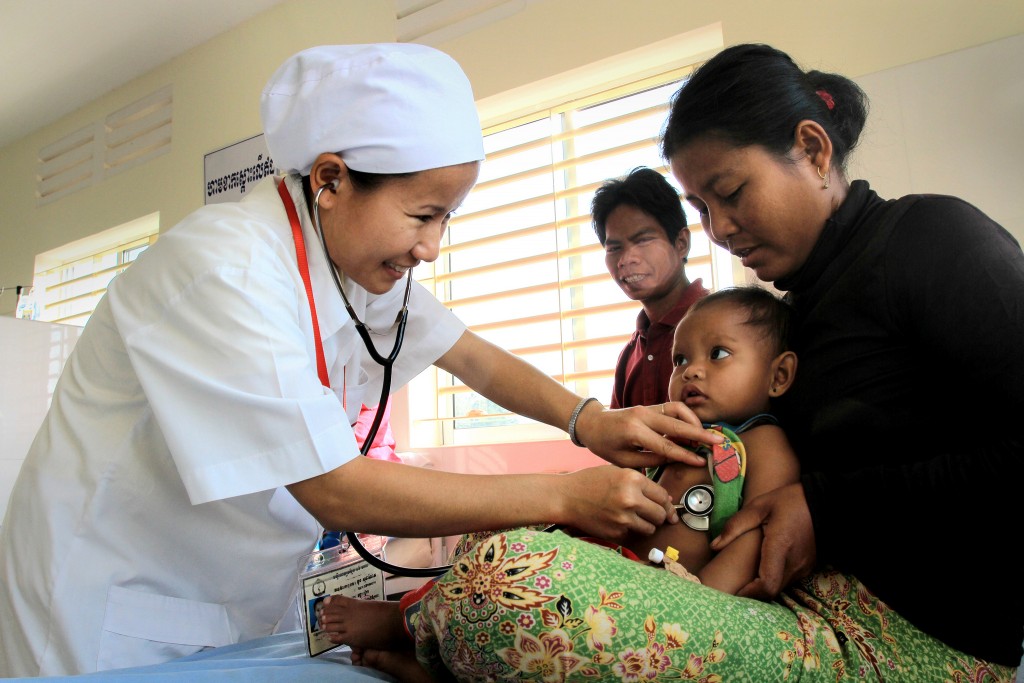
បុគ្គលិកពេទ្យកំពុងស្ដាប់ចង្វាក់បេះដូងទារក នៅមន្ទីរពេទ្យ ១៦មករា ខេត្តព្រះវិហារ ប្រទេសកម្ពុជា. រូបភាព ថតដោយ ធនាគារពិភពលោក, ៣០ មករា ២០១៣. អាជ្ញាប័ណ្ណ CC BY-NC-ND 2.0.
ការអភិវឌ្ឍផ្នែកសង្គម បង្ហាញឱ្យឃើញពីបញ្ហាសង្គមយ៉ាងជ្រាលជ្រៅ ជាពិសេស ភាពក្រីក្រភាពគ្មានការងារធ្វើ និងការមិនរាប់បញ្ចូលផ្នែកសង្គមផ្សេងទៀត1 និងស្វែងរកការកំណត់នូវភាពក្រីក្រចំពោះវិសាលគមនៃឧបសគ្គនានាទាំងផ្នែកសង្គម និងរចនាសម្ព័ន្ធ ជំនួសកម្រិតប្រាក់ចំណូល ។
ប្រទេសកម្ពុជា សម្រេចបាននូវគោលដៅអភិវឌ្ឍន៍សហស្សវត្សរ៍របស់ខ្លួនមួយចំនួន ដូចជា ការកាត់បន្ថយអត្រាមរណភាពទារក និងមាតា បីភាគបួន កម្រិតប្រាក់ចំណូលបានកើនឡើង ហើយកម្រិតនៃភាពក្រីក្រ បានធ្លាក់ចុះ ចំណែកឯស្ថិតិសុខាភិបាល និងវិស័យអប់រំជាច្រើនទៀត បានប្រសើរឡើងយ៉ាងខ្លាំង ។
ទោះយ៉ាងណាក៏ដោយ ក៏នៅមានការប្រឈមធំៗជាច្រើន សម្រាប់ប្រជាជនជាច្រើន ដែលរស់នៅតាមជនបទ ដូចជា ការទទួលបានសេវាសុខភាព ឬ សេវាអប់រំ និងការផ្គត់ផ្គង់ អគ្គិសនី នៅមានកម្រិតនៅឡើយ រីឯ ប្រជាជនមួយចំនួនធំ បានទទួលរងផលប៉ះពាល់ ដោយ សារជំងឺផ្សេងៗ ដូចជា ជំងឺគ្រុនចាញ់ ឬ ជំងឺរបេង និងការអប់រំផ្នែកមធ្យមសិក្សា ក៏នៅមាន កម្រិតទាបនៅឡើយ។2
កម្មវិធីអភិវឌ្ឍរបស់អង្គការសហប្រជាជាតិ ស្តីពីការអភិវឌ្ឍមនុស្ស កំណត់ធាតុសំខាន់ៗចំនួនបី។ “មនុស្សគួរតែ៖
- មានជីវិតរស់នៅឱ្យបានយូរអង្វែង និង មានសុខភាពល្អ (អាយុកាលជាមធ្យម)
- ទទួលបាននូវចំណេះដឹង (បានចូលសាលារៀន)
- ទទួលបាននូវធនធានដែលចាំបាច់ សម្រាប់ការរស់នៅឱ្យបានសមរម្យ (អំណាចនៃការទិញ មានភាពស្មើរគ្នា និងប្រាក់ចំណូល)។”3
ចាប់តាំងពីឆ្នាំ ១៩៨០ ដល់ ឆ្នាំ ២០១៣ ប្រទេសកម្ពុជា បានធ្វើឱ្យប្រសើរឡើងនូវសន្ទស្សន៍នៃការអភិវឌ្ឍន៍មនុស្ស គឺពី ០.២៥១ ទៅដល់ ០.៥៨៤។ ទោះបីជាយ៉ាងណាក៏ដោយ នៅក្នុងឆ្នាំ ២០១៣ ប្រទេសកម្ពុជា នៅតែជាប់ចំណាត់ថ្នាក់ ១៣៦ ក្នុងចំណោម ១៨៧ ប្រទេស នៅក្នុងប្រភេទនៃការអភិវឌ្ឍជាមធ្យម។4
ភាពក្រីក្រ និងប្រាក់ចំណូល
ប្រទេសកម្ពុជា បានសម្រេចលើស គោលដៅកាត់បន្ថយភាពក្រីក្រ នៅក្នុងគោលដៅអភិវឌ្ឍន៍សហស្សវត្សរ៍របស់ខ្លួន។ សមាមាត្រនៃប្រជាជនដែលរស់នៅក្នុងភាពក្រីក្រខ្លាំង គឺតិចជាង ១.១៥ ដុល្លារសហរដ្ឋអាមេរិក ក្នុងមួយថ្ងៃ គឺបានធ្លាក់ចុះពី ៥៣.០ ភាគរយ ដល់ ២០.៥ ភាគរយ នៅចន្លោះឆ្នាំ ២០០៤ និង ២០១១ ។ ភាពប្រសើរឡើងជិតពាក់កណ្ដាលនេះ ត្រូវបានសន្មត់ថា មកពីតម្លៃអង្ករ និងការផលិត មានការកើនឡើងខ្ពស់ជាងមុន ដែលបានបង្កើនប្រាក់ចំណូល ដល់កម្មករកសិដ្ឋាន និងអ្នកដាំ។ ទោះបីជាយ៉ាងណាក៏ដោយ ប្រជាជនមួយចំនួនធំនៅតែរស់នៅជិតទៅនឹងបន្ទាត់នៃភាពក្រីក្រ ហើយងាយរងគ្រោះទៀតផង។ ចំនួនមនុស្សដែលអាចរកប្រាក់បានតិចជាង ២.៣០ ដុល្លារសហរដ្ឋអាមេរិក សម្រាប់មនុស្សម្នាក់ ក្នុងមួយថ្ងៃ គឺបានកើនឡើងពី ៤.៦ លាននាក់ នៅឆ្នាំ ២០០៤ ដល់ ៨.១ លាននាក់ នៅឆ្នាំ ២០១១។5 វិសមភាពនៃប្រាក់ចំណូលនៅក្នុងប្រទេសកម្ពុជា គឺប្រហាក់ប្រហែលនឹងប្រទេសលោកខាងលិចដែរ និងទាបជាងនៅសហរដ្ឋអាមេរិក បើយោងតាមស្តង់ដារវាស់វែងការអភិវឌ្ឍជាច្រើន។ ឧទាហរណ៍ពិន្ទុមេគុណបែបជីនី (សម្រាប់វាស់វិសមភាពនៃប្រាក់ចំណូល ដែល ០ តំណាងឱ្យសមភាពល្អឥតខ្ចោះ និង ១០០ តំណាងឱ្យវិសមភាពខ្លាំង) របស់ប្រទេសកម្ពុជាគឺ ៣១.៨ ក្នុងឆ្នាំ ២០១១ ខណៈ ប្រទេសអៀកឡង់ មានពិន្ទុ ៣២.១ ក្នុងឆ្នាំ ២០១០ និង ប្រទេស អាល្លឺម៉ង់ ៣០.៦។ ពិន្ទុសម្រាប់ សហរដ្ឋអាមេរិក ក្នុងឆ្នាំ ២០១០ គឺ ៤១.១ ។ វិសមភាពប្រាក់ចំណូល បានធ្លាក់ចុះ នៅក្នុងប្រទេសកម្ពុជា នេះបើយោងតាមតួលេខរបស់ធនាគារពិភពលោក និង អង្គការសហប្រជាជាតិ។6
ក្នុងរយៈពេលពីរទសវត្សរ៍ចុងក្រោយនេះ ប្រទេសកម្ពុជា មានការអភិវឌ្ឍផ្នែកសេដ្ឋកិច្ចគួរឱ្យកត់សម្គាល់ និងមានការផ្លាស់ប្តូរផ្នែកសង្គមផងដែរ។ ផលិតផលក្នុងស្រុកសរុបក្នុងមួយឆ្នាំ សម្រាប់ប្រជាជនម្នាក់ បានកើនឡើងពី ២៩៩ ដុល្លាសហរដ្ឋអាមេរិច ក្នុងឆ្នាំ ២,០០០ ដល់ ១,០០៧ ដុល្លាសហរដ្ឋអាមេរិច ក្នុងឆ្នាំ ២០១៣។7
ស្ថិតិអំពីសុខភាព
អាយុកាលជាមធ្យម របស់ប្រជាជនកម្ពុជា បានកើនឡើង ២៥ ឆ្នាំ នៅចន្លោះឆ្នាំ ១៩៨០ និងឆ្នាំ ២០១២។8 អាយុកាលជាមធ្យមនៅឆ្នាំ ២០១២ គឺ ៧១.៩ ឆ្នាំ។9 អង្គការ យូនីសេហ្វ បានប៉ាន់ប្រមាណថាអត្រាមរណភាពមាតា គឺមានចំនួន ១៧០នាក់ ក្នុងចំណោម ១០០,០០០ នាក់ក្នុងឆ្នាំ ២០១៣។ នៅក្នុងឆ្នាំ ១៩៩០ អត្រាមរណៈមាតាក្នុងប្រទេស កម្ពុជា គឺមាន ១,២០០ នាក់។ តួរលេខនេះ បង្ហាញពីការធ្លាក់ចុះ ៨៦ ភាគរយ ។ សមាមាត្រសម្រាប់ទ្វីបអាស៊ីទាំងមូល គឺ ៣៥០ នាក់ នៅឆ្នាំ ១៩៩០ និង ១៤០នាក់ ក្នុងឆ្នាំ ២០១៣។ តួរលេខនេះបង្ហាញពីការធ្លាក់ចុះ ៦១ ភាគរយ។10
អត្រាមរណភាពទារក (កុមារស្លាប់មុនអាយុ ១ ខួប) បានប្រែប្រួលតិចតួចនៅក្នុងឆ្នាំ ១៩៩០11 ប៉ុន្តែនៅចន្លោះឆ្នាំ ២០០០ និងឆ្នាំ ២០១៣ តួរលេខនេះ បានធ្លាក់ចុះពី ៩៥នាក់12ក្នុងចំណោមទារក១០០០នាក់ មកត្រឹម ៣៣13 នាក់។ ខណៈដែលកត្តាទាំងអស់នេះ កំពុងត្រូវបានកែលម្អ វិទ្យាស្ថានអន្តរជាតិស្រាវជ្រាវគោលនយោបាយស្បៀងអាហារ បានដាក់ពិន្ទុឱ្យប្រទេសកម្ពុជា ១៦.១ នៅក្នុងសន្ទស្សន៍ភាពអត់ឃ្លានជាសកល ឆ្នាំ ២០១៤។ ពិន្ទុនេះចាត់ដាក់ប្រទេសកម្ពុជា នៅក្នុងប្រភេទប្រទេសដែលប្រឈមនឹងបញ្ហាភាពអត់ឃ្លាន “ធ្ងន់ធ្ងរ”។14
ការរីកចំរើនទៅមុខនេះ គឺភាគច្រើនអាស្រ័យទៅលើកញ្ចប់ថវិការរបស់ដៃគូជំនួយ។ ជាឧទាហរណ៍ នៅក្នុងរយៈពេលប៉ុន្មានឆ្នាំ ដែលចន្លោះពី ២០០០ដល់២០០៩ ជំនួយអភិវឌ្ឍន៍សម្រាប់សេវាសុខភាពបានកើនក្នុងកម្រិតមធ្យម ១១.៣ ភាគរយក្នុងមួយឆ្នាំ ខណៈពេលដែលចន្លោះពី ២០១០ ដល់២០១៥ ការកើនឡើងនេះបានធ្លាក់ចុះត្រឹម ១.២ ភាគរយក្នុងមួយឆ្នាំតែប៉ុណ្ណោះ។15 កំណើនជំនួយភាគច្រើនត្រូវបានផ្លាស់ប្តូរគោលដៅរបស់ខ្លួនដូចជា ពីជំងឺអេដស៍ គ្រុនចាញ់និងរបេង ទៅបញ្ហាសុខភាពកុមារ, មាតា និងទារកជាដើម។16
ការអប់រំ
ប្រទេសកម្ពុជា មានលក្ខណៈប្រកៀកប្រកិតទៅនឹងការសម្រេចបាននូវ គោលដៅអភិវឌ្ឍន៍សហស្សវត្សរ៍សកលសម្រាប់ការអប់រំ កម្រិតបឋមសិក្សា ដោយសម្រេចបាននូវអត្រាចុះឈ្មោះចូលរៀន ៩៧ ភាគរយ។ ទោះជាយ៉ាងណា អត្រាដ៏ខ្ពស់នេះ ជារនាំងបិទបាំងភាពទន់ខ្សោយមួយចំនួនដូចជា បោះបង់ការសិក្សាដែលមានកម្រិតខ្ពស់ និងការអប់រំដែលមានគុណភាពខ្សោយផងដែរ។ ការចុះឈ្មោះចូលរៀន នៅកម្រិតអនុវិទ្យាល័យ គឺនៅមានកម្រិតទាបនៅឡើយ គឺ៥៧ ភាគរយ។ រយៈពេលដែលសិស្សចំណាយនៅក្នុងសាលារៀនជាមធ្យម នៅក្នុងប្រទេសកម្ពុជា បានកើនឡើងពី ០.៨ ឆ្នាំ ទៅ ៥.៨ ឆ្នាំ នៅចន្លោះឆ្នាំ ១៩៨០ និង ២០១៣។17
នៅក្នុងខែមករាឆ្នាំ ២០១៦ រដ្ឋាភិបាលបានដាក់ចេញគោលនយោបាយជាតិជាលើកដំបូងសម្រាប់ការអភិវឌ្ឍកុមារ ដែលត្រូវបានត្រួតត្រាដោយក្រុមប្រឹក្សាជាតិកម្ពុជាដើម្បីកុមារ។ ក្នុងចំណោមបញ្ហាផ្សេងទៀត គោលនយោបាយនេះ មានគោលបំណងដើម្បីកាត់បន្ថយអត្រាបោះបង់ចោលការសិក្សារបស់សិស្ស និងបង្កើនឱកាសបណ្តុះបណ្តាលជំនាញវិជ្ជាជីវៈ។18
ការការពារផ្នែកសង្គម
គោលនយោបាយ និងកម្មវិធីគាំពារផ្នែកសង្គម មានតួនាទី ទប់ស្កាត់ គ្រប់គ្រង និងដោះស្រាយ ស្ថានភាពដែលប៉ះពាល់ដល់សុខុមាលភាពរបស់មនុស្ស ដូចជា ជំងឺ មាតុភាព ពិការភាព ឬ ភាពចាស់ជរា ភាពគ្មានការងារធ្វើ និង វិបត្តិសេដ្ឋកិច្ច ឬ គ្រោះមហន្តរាយធម្មជាតិ ជាដើម។ កម្មវិធីគំាពារផ្នែកសង្គម មានដូចជា ការធានារ៉ាប់រងផ្នែកសង្គម ការផ្តល់ជំនួយផ្នែកសង្គម គម្រោងខ្នាតតូច និង គម្រោងដែលមាននៅតាមមូលដ្ឋាន ដើម្បីការពារសហគមន៍ និង ការការពារកុមារ។
ប្រទេសកម្ពុជា បានចំណាយប្រាក់ប្រមាណជាង១ ភាគរយ នៃផលិតផលក្នុងស្រុកសរុប របស់ខ្លួនទៅលើកម្មវិធីគាំពារផ្នែកសង្គម ប្រៀបធៀបជាមួយនឹងប្រទេសវៀតណាម ដែលបានបានចំណាយ ៤.៧ ភាគរយ និង ប្រទេសថៃ គឺក្រោម ៤ ភាគរយបន្តិច។19
សិទ្ធមនុស្ស
ខណៈដែលរាជរដ្ឋាភិបាលកម្ពុជា បានបង្កើតឡើងនូវគណៈកម្មាធិការសិទ្ធិមនុស្សដោយសមាជិកពីគណបក្សកាន់អំណាច ត្រូវបានទទួលរងការរិះគន់ចំពោះភាពលម្អៀង និងកង្វះវិធានការ។20 គោលការណ៍ទីក្រុងប៉ារីសរបស់អង្គការសហប្រជាជាតិ ដែលគ្របដណ្តប់ទៅលើលក្ខណៈវិនិច្ឆ័យសម្រាប់ស្ថាប័នសិទ្ធិមនុស្សជាតិ បានចែងថា ដើម្បីឱ្យមានប្រសិទ្ធិភាពពួកគេគួរតែមានស្វ័យភាពពីរដ្ឋាភិបាល ធានាដោយច្បាប់។21 អ្នករាយការណ៍ពិសេសរបស់អង្គការសហប្រជាជាតិស្តីពីស្ថានភាពសិទ្ធិមនុស្សនៅកម្ពុជា រ៉ូណា ស្មីទ ត្រូវបានតែងតាំងនៅខែមិនា ឆ្នាំ២០១៥ ។22
ធ្វើបច្ចុប្បន្នភាពចុងក្រោយ៖ ៩ តុលា ២០១៥
ឯកសារយោង
- 1. អង្គការសហប្រជាជាតិ នាយកដ្ឋានសេដ្ឋកិច្ច និងកិច្ចការសង្គម (DESA). “សេចក្តីប្រកាស កូផែនហេហ្គិនស្តីពីការអភិវឌ្ឍផ្នែកសង្គម ឆ្នាំ ១៩៩៥.” ចូលអាន ២៨ មិថុនា ២០១៥. [ភាសាអង់គ្លេស] http://www.un.org/esa/socdev/wssd/text-version/agreements/decparti.htm.
- 2. កម្មវិធីអភិវឌ្ឍអង្គការសហប្រជាជាតិ. ២០១៣. “សេចក្តីប្រាថ្នានៅតំបន់អាស៊ីប៉ាស៊ីហ្វិក៖ ទស្សនវិស័យសម្រាប់របៀបវារៈនៃការអភិវឌ្ឍ ឆ្នាំ២០១៥ របាយការណ៍គោលដៅអភិវឌ្ឍន៍សហស្សវត្សរ៍ ឆ្នាំ ២០១២/១៣ ប្រចាំតំបន់តំបន់អាស៊ីប៉ាស៊ីហ្វិក.” ចូលអាន ៨ មេសា ២០១៥. [ភាសាអង់គ្លេស] http://www.undp.org/content/dam/undp/library/MDG/english/MDG%20Regional%20Reports/AP/RBAP-RMDG-Report-2012-2013.pdf
- 3. កម្មវិធីអភិវឌ្ឍន៍អង្គការសហប្រជាជាតិ. “របាយការណ៍វិភាគអំពីការអភិវឌ្ឍមនុស្សស្តីពីប្រទេសកម្ពុជា.” ចូលអាន ២៨ មិថុនា ២០១៥. [ភាសាអង់គ្លេស] http://www.kh.undp.org/content/cambodia/en/home/library/poverty/2013-hdr-analysison-on-cambodia.html
- 4. កម្មវិធីអភិវឌ្ឍន៍អង្គការសហប្រជាជាតិ. “ប្រវត្តិរូបប្រទេស៖ ប្រទេសកម្ពុជា”. ចូលអាន ២៨ មិថុនា ២០១៥. [ភាសាអង់គ្លេស] http://hdr.undp.org/en/countries/profiles/KHM
- 5. Ulrich Zachau (នាយកប្រតិបត្តិធានាគារពិភពលោក ប្រចាំប្រទេសកម្ពុជា). “ហើយឥឡូវនេះ ចូរក្រលេកមើលការពិតដែលជាផ្នែកមួយដ៏លំបាក.” ការសែតភ្នំពេញបុស្តិ, ចេញផ្សាយ ១៩ កុម្ភៈ ២០១៤. [ភាសាអង់គ្លេស] http://www.phnompenhpost.com/analysis-and-op-ed/and-now-really-hard-part
- 6. ធនាគារពិភពលោក. “ឩបសម្ព័ន្ធវាស់វែងប្រាក់ចំណូល (ការព្យាកររបស់ធនាគារពិភពលោក).” ចូលអាន ២៨ មិថុនា ២០១៥. [ភាសាអង់គ្លេស] http://data.worldbank.org/indicator/SI.POV.GINI
- 7. ធនាគារពិភពលោក. “ផលិតផលក្នុងស្រុកសរុប (គិតជាដុល្លាបច្ចុប្បន្ន).” ចូលអាន ២៨ មិថុនា ២០១៥. http://data.worldbank.org/indicator/NY.GDP.PCAP.CD?page=2
- 8. កម្មវិធីអភិវឌ្ឍន៍អង្គការសហប្រជាជាតិ. ២០១៣. “របាយការណ៍អភិវឌ្ឍន៍មនុស្ស៖ ការកើនឡើងការវិភាគនៅភាគខាងត្បូង ស្តីពីប្រទេសកម្ពុជា” ចូលអាន ២៨ មិថុនា ២០១៥. [ភាសាអង់គ្លេស] http://www.kh.undp.org/content/dam/cambodia/docs/PovRed/2013HDRAnalysisonCambodia.pdf
- 9. កម្មវិធីអភិវឌ្ឍន៍អង្គការសហប្រជាជាតិ. “របាយការណ៍ឩបសម្ព័ន្ធអភិវឌ្ឍន៍មនុស្សឆ្នាំ ២០១៤.” ចូលអាន២៧ មិថុនា ២០១៥.[ភាសាអង់គ្លេស] http://hdr.undp.org/en/countries
- 10. មូលនិធិសង្គ្រោះកុមារអង្គការសហប្រជាជាតិ. “មរណភាពមាតាបានធ្លាក់ចុះជាលំដាប់ គិតចាប់តាំងពីឆ្នាំ ១៩៩០ មក ប៉ុន្តែមិនទាន់បានគ្រប់គ្រាន់នៅឡើយដើម្បីបំពេញគោលដៅអភិវឌ្ឍន៍សហសវត្ស.” ចូលអាន ២២ ឧសភា ២០១៥. [ភាសាអង់គ្លេស] http://data.unicef.org/maternal-health/maternal-mortality.html
- 11. ធនាគារពិភពលោក. “អត្រាមរណភាពទារក (ក្នុង ១០០០ នាក់).” ចូលអាន ២២ ឧសភា ២០១៥. [ភាសាអង់គ្លេស] http://data.worldbank.org/indicator/SP.DYN.IMRT.IN?page=4
- 12. មូលនិធិសង្គ្រោះកុមារអង្គការសហប្រជាជាតិ. “សុខភាព និងអាហារូបត្ថម្ភរបស់ មាតា ទារក និងកុមារ.” ចូលអាន ២២ ឧសភា ២០១៥. [ភាសាអង់គ្លេស] http://www.unicef.org/cambodia/6.Maternal.pdf
- 13. វិទ្យាស្ថានស្ថិតិជាតិនៃក្រសួងផែនការ. ២០១៣. “របាយការណ៍ការស្ទង់មតិអន្តរកណ្តាលកម្ពុជា.” ចូលអាន ៨ មករា ២០១៥. [ភាសាអង់គ្លេស] http://countryoffice.unfpa.org/cambodia/drive/CIPS_Report_English_Final.pdf
- 14. វិទ្យាស្ថានស្រាវជ្រាវគោលនយោបាយស្បៀងអន្តរជាតិ, (IFPRI) Welthungerhilfe (WHH), អង្គការ Concern Worldwide. ២០១៤. “ទិន្នន័យឩបសម្ព័ន្ធភាពអត់ឃ្លានជាសកល.” វ៉ាស៊ីនតោន៖វិទ្យាស្ថានស្រាវជ្រាវគោលនយោបាយស្បៀងអន្តរជាតិ (IFPRI) [ប្រចាំប្រទេសកម្ពុជា]. ចូលអាន ៩ តុលា ២០១៥.[ភាសាអង់គ្លេស] http://dx.doi.org/10.7910/DVN/27557
- 15. Yesemia Amaro, ២០១៦.”ការសិក្សារ៖ ការផ្លាស់ប្តូរការផ្តោតសំខាន់របស់អ្នកផ្តល់ជំនួយអាចនឹងផ្តល់ផលលំបាក”, កាសែតភ្នំពេញប៉ុស្តិ៍ ចុះថ្ងៃទី២២ ខែមេសា ឆ្នាំ២០១៦។
- 16. ដូចឯកសារយោងខាងដើម។
- 17. ក្រសួងផែនការ. “ផែនការយុទ្ធសាស្ត្រអភិវឌ្ឍន៍ជាតិឆ្នាំ២០១៤ – ២០១៨.” ចូលអាន ២៨ មករា ២០១៥. http://www.mop.gov.kh/LinkClick.aspx?fileticket=XOvSGmpI4tE%3d&tabid=216&mid=705
- 18. Igor Kossov,២០១៦.”ការចាប់ផ្តើមនៃផែនការសុខុមាលភាពកុមារត្រូវបានសម្គាល់”, កាសែតភ្នំពេញប៉ុស្តិ៍ ចុះថ្ងៃទី២១ ខែមករា ឆ្នាំ២០១៦។ ចូលមើលថ្ងៃទី៣០ ខែមករា ឆ្នាំ២០១៦។ http://www.phnompenhpost.com/national/launch-child-welfare-plan-marked
- 19. ធនាគារអភិវឌ្ឍន៍អាស៊ី. “ឩបសម្ព័ន្ធការការពារផ្នែកសង្គម ការវាយតម្លៃចំពោះលទ្ធផលសម្រាប់តំបន់អាស៊ី និងប៉ាស៊ីហ្វិក.” ទីក្រុងម៉ានីល៖ ២០១៣. ទំព័រ ២២. ចូលអាន ២៧ មិថុនា ២០១៥[ភាសាអង់គ្លេស] http://adb.org/sites/default/files/pub/2013/social-protection-index.pdf
- 20. ឃួន ណារីម. “ក្រុមនានា ចង់បានស្ថាប័នសិទិ្ធមនុស្សឯករាជ្យមួយ.” ការសែតឌឹខេមបូឌាដេលី ចេញផ្សាយ ៣០ វិច្ឆិកា ២០១៣. ចូលអាន ២៣ កញ្ញា ២០១៥. [ភាសាអង់គ្លេស] https://www.cambodiadaily.com/archives/groups-want-independent-human-rights-body-48227/
- 21. វេទិកានៃវិទ្យាស្ថានសិទ្ធិមនុស្សជាតិប្រចាំតំបន់អាស៊ីប៉ាស៊ីហ្វិក. “គោលការណ៍ទីក្រុងប៉ារីស.” ចូលអាន ២២ កញ្ញា ២០១៥. [ភាសាអង់គ្លេស] http://www.asiapacificforum.net/support/what-are-nhris/paris-principles/
- 22. អង្គការសហប្រជាជាតិស្តីពីសិទ្ធិមនុស្ស. “អ្នករាយការណ៍ពិសេសស្តីពីស្ថានភាពសិទ្ធិមនុស្សនៅក្នុងប្រទេសកម្ពុជា.” ចូលអាន ២២ កញ្ញា ២០១៥.[ភាសាអង់គ្លេស] http://www.ohchr.org/EN/HRBodies/SP/CountriesMandates/KH/Pages/SRCambodia.aspx

